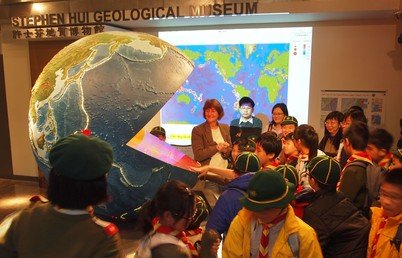The Rock Stars of HKU
The Stephen Hui Geological Museum was, until recently, HKU's hidden gem. Opened as the first geological museum in Hong Kong in 2009 on the ground and first floor of the James Hsioung Lee Science Building, it attracted mainly school groups in the past (with about 3,500 annual participants in the 2 hour long guided museum tours). But all that changed with the opening of the HKU MTR station earlier this year.
The Stephen Hui Geological Museum was, until recently, HKU's hidden gem. Opened as the first geological museum in Hong Kong in 2009 on the ground and first floor of the James Hsioung Lee Science Building, it attracted mainly school groups in the past (with about 3,500 annual participants in the 2 hour long guided museum tours). But all that changed with the opening of the HKU MTR station earlier this year.
"That first week was like JUPAS open day," said museum curator Dr Petra Bach, and it has stayed busy ever since as more individual visitors are using the easy MTR access to come to appreciate exhibits that enchant both the eye and the mind.
Jewel-coloured rocks and minerals, intricately-patterned fossils of insects and leaves (including a finger of lightning preserved in sand that melted and cooled when it struck), a 1.5-metre interactive globe, and a cluster of real dinosaur eggs that one can touch are among the displays in the two-storey museum.
Dr Bach has been the designer behind the scenes, drawing on collections that include Dr Stephen Hui's private mineral collection, the Department of Earth Sciences' own materials, and fossils from Hong Kong and Mainland China. The late Dr Stephen Hui was a mining geologist and philanthropist who collected samples from around the world, which now formed the core collection in the museum's Earth Material gallery. His mineral donation and the continuous support by his family made the establishment of the Stephen Hui Geological Museum possible.
The accessible displays are intended to not only showcase ancient artefacts, but also provide an object-based learning facility for understanding the nature and evolution of our planet Earth and make it relevant to the modern day.
"We need to protect and sustain our planet Earth that provides us with all our resources, and what do you protect? Something you know and love. This is why we use a diverse range of about 1500 authentic fossils, minerals and rocks that people can see and touch, and arranged in a context of a story about the evolution of our Earth so that visitors can learn to appreciate our natural world and get that 'wow' factor," she said.
The museum's setting adds to the impression because its large windows evoke the outdoor world where earth scientists do most of their work. School children can sit by the dinosaur eggs "as if sitting in the field," she said.
There are four main galleries - Dynamic Earth, Earth Evolution, Earth Materials and the Geological History of Hong Kong - and a new exhibit on climate change that opened this year, drawing on the department's own research to reinforce the idea of the need to protect and sustain planet Earth.
Besides the museum tours, the museum offers loan sets for educational bodies, workshops in collaboration with Hong Kong partners as well as temporary exhibitions. Dr Bach estimated about 20,000 visitors traipsed through the museum each year.
The facility is free of charge, and also shares its information on a website. Dr Bach said the bilingual webpage with it's Chinese-language pages were particularly popular because there still is limited information online in Chinese about earth sciences – thus helping to extend the museum's impact into the virtual world.
Dr Petra BACH of the Department of Earth Sciences received the Faculty Knowledge Exchange Award 2015 of the Faculty of Science for 'Design and Establishment of the Stephen Hui Geological Museum'.


